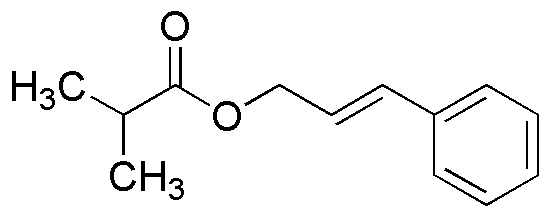Cinnamyl isobutyrate is widely utilized in research focused on:
- Fragrance Industry: This compound is commonly used in perfumes and scented products due to its pleasant, sweet, and spicy aroma, making it a popular choice for creating appealing fragrances.
- Food Flavoring: It serves as a flavoring agent in the food industry, enhancing the taste of various products, particularly in baked goods and confections, where its sweet and fruity notes are desirable.
- Cosmetics: Cinnamyl isobutyrate is incorporated into cosmetic formulations, such as lotions and creams, to provide a pleasant scent and improve the overall sensory experience for consumers.
- Aromatherapy: In the wellness sector, it is used in essential oil blends and diffusers for its aromatic properties, promoting relaxation and a sense of well-being.
- Research Applications: This compound is also studied for its potential therapeutic properties, including antimicrobial and antioxidant effects, making it relevant in pharmaceutical research.
General Information
Properties
Safety and Regulations
Applications
Cinnamyl isobutyrate is widely utilized in research focused on:
- Fragrance Industry: This compound is commonly used in perfumes and scented products due to its pleasant, sweet, and spicy aroma, making it a popular choice for creating appealing fragrances.
- Food Flavoring: It serves as a flavoring agent in the food industry, enhancing the taste of various products, particularly in baked goods and confections, where its sweet and fruity notes are desirable.
- Cosmetics: Cinnamyl isobutyrate is incorporated into cosmetic formulations, such as lotions and creams, to provide a pleasant scent and improve the overall sensory experience for consumers.
- Aromatherapy: In the wellness sector, it is used in essential oil blends and diffusers for its aromatic properties, promoting relaxation and a sense of well-being.
- Research Applications: This compound is also studied for its potential therapeutic properties, including antimicrobial and antioxidant effects, making it relevant in pharmaceutical research.
Documents
Safety Data Sheets (SDS)
The SDS provides comprehensive safety information on handling, storage, and disposal of the product.
Product Specification (PS)
The PS provides a comprehensive breakdown of the product’s properties, including chemical composition, physical state, purity, and storage requirements. It also details acceptable quality ranges and the product's intended applications.
Certificates of Analysis (COA)
Search for Certificates of Analysis (COA) by entering the products Lot Number. Lot and Batch Numbers can be found on a product’s label following the words ‘Lot’ or ‘Batch’.
*Catalog Number
*Lot Number
Certificates Of Origin (COO)
This COO confirms the country where the product was manufactured, and also details the materials and components used in it and whether it is derived from natural, synthetic, or other specific sources. This certificate may be required for customs, trade, and regulatory compliance.
*Catalog Number
*Lot Number
Safety Data Sheets (SDS)
The SDS provides comprehensive safety information on handling, storage, and disposal of the product.
DownloadProduct Specification (PS)
The PS provides a comprehensive breakdown of the product’s properties, including chemical composition, physical state, purity, and storage requirements. It also details acceptable quality ranges and the product's intended applications.
DownloadCertificates of Analysis (COA)
Search for Certificates of Analysis (COA) by entering the products Lot Number. Lot and Batch Numbers can be found on a product’s label following the words ‘Lot’ or ‘Batch’.
*Catalog Number
*Lot Number
Certificates Of Origin (COO)
This COO confirms the country where the product was manufactured, and also details the materials and components used in it and whether it is derived from natural, synthetic, or other specific sources. This certificate may be required for customs, trade, and regulatory compliance.

